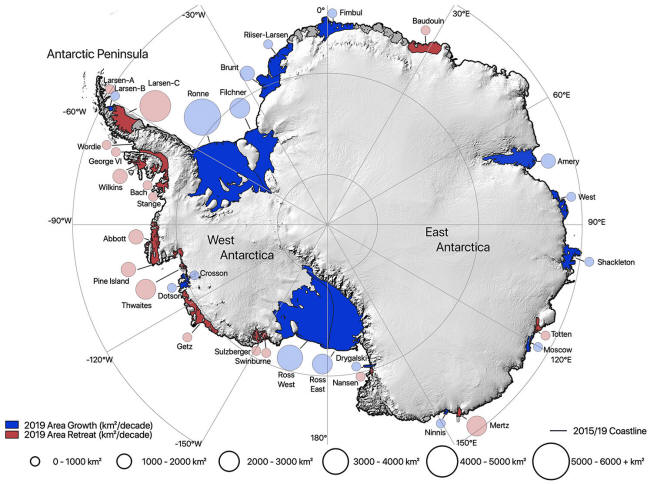|

by Pierre Gosselin
January
03, 2024
from
Notrickszone Website

Image: Andreasen et al (2023)
Collapsing
Antarctic Scare Narrative…
Four new
studies in prestigious journals
show Antarctic
ice shelf as stable as ever.
Andreasen et al
(2023) finds net gain
A
study by Julia R. Andreasen
and colleagues looked at the changes in ice shelves, Antarctic-wide,
using MODIS (Moderate Resolution Imaging Spectroradiometer)
satellite data from 2009 to 2019.
They found that over the period 2009-2019, overall Antarctic ice
shelf area grew by 5305 km2.
18 ice shelves retreated somewhat and 16 larger shelves grew in
terms of area.
"Our observations
show that Antarctic ice shelves gained 661 Gt (Giga Tons) of ice
mass over the past decade," the scientists summarized.
Banwell et al
(2023) meltwater volume dropped
Another
new paper by Alison F. Banwell
et al published in the journal Geophysical Research Letters
looked at the duration and amount of surface ice melting on
Antarctica’s ice shelves from 1980 to 2021, using microwave
satellite data the snow model SNOWPACK.
Result:
They found that the
highest meltwater volumes were produced on the Peninsula,
reaching a peak in the 1992/1993 and 1994/1995, and that
SNOWPACK calculated,
"a small, but
significant, decreasing trend in both annual melt days and
meltwater production volume over the 41 years."
Frazer et al
(2023)
Another study published in
Nature authored by Christie D.W. Frazer et al
(2023) found that although West Antarctica - particularly from Pine
Island and Thwaites glaciers - has seen dramatic ice losses in
recent decades, projections of their future rate are confounded by
limited observations.
Also, looking at the period 2003 and 2015, they found rates of
glacier retreat and acceleration to be extensive along the
Bellingshausen Sea coastline, but slowed along the Amundsen Sea.
The authors conclude:
Our results provide
direct observations that the pace, magnitude and extent of ice
destabilization around West Antarctica vary by location, with
the Amundsen Sea response most sensitive to interdecadal
atmosphere-ocean variability.
Balco et al
(2023) 35 meters thinner thousands of years ago
Finally, in yet
another new published paper by
Greg Balco et al (2023), the authors looked at subglacial
bedrock cores show that the West Antarctic Ice Sheet (WAIS)
between Thwaites and Pope glaciers and found it,
"was at least 35 m
thinner than present in the past several thousand years and then
subsequently thickened."
Moreover:
"A past episode of
ice sheet thinning that took place in a similar, although not
identical, climate was not irreversible.
We propose that the
past thinning-thickening cycle was due to a glacioisostatic
rebound feedback, similar to that invoked as a possible
stabilizing mechanism for current grounding line retreat, in
which isostatic uplift caused by Early Holocene thinning led to
relative sea level fall favoring grounding line advance."
|